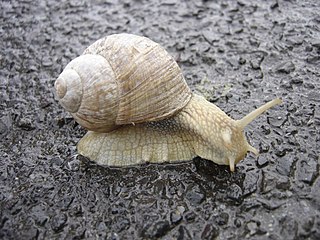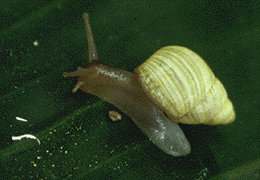
A snail is, in loose terms, a shelled gastropod. The name is most often applied to land snails, terrestrial pulmonate gastropod molluscs. However, the common name snail is also used for most of the members of the molluscan class Gastropoda that have a coiled shell that is large enough for the animal to retract completely into. When the word "snail" is used in this most general sense, it includes not just land snails but also numerous species of sea snails and freshwater snails. Gastropods that naturally lack a shell, or have only an internal shell, are mostly called slugs, and land snails that have only a very small shell are often called semi-slugs.

Powelliphanta is a genus of large, air-breathing land snails, pulmonate gastropods in the family Rhytididae, found only in New Zealand. They are carnivorous, eating invertebrates, mostly native earthworms. Often restricted to very small areas of moist forest, they are prey to introduced mammalian predators, and many species are threatened or endangered.
Located about 2300 miles (3680 km) from the nearest continental shore, the Hawaiian Islands are the most isolated group of islands on the planet. The plant and animal life of the Hawaiian archipelago is the result of early, very infrequent colonizations of arriving species and the slow evolution of those species—in isolation from the rest of the world's flora and fauna—over a period of at least 5 million years. As a consequence, Hawai'i is home to a large number of endemic species. The radiation of species described by Charles Darwin in the Galapagos Islands which was critical to the formulation of his theory of evolution is far exceeded in the more isolated Hawaiian Islands.

Captain Frederick Wollaston Hutton was an English-New Zealand scientist who applied the theory of natural selection to explain the origins and nature of the natural history of New Zealand. An army officer in early life, he then had an academic career in geology and biology. He became one of the most able and prolific nineteenth century naturalists of New Zealand.

Sea snail is a common name for slow-moving marine gastropod molluscs, usually with visible external shells, such as whelk or abalone. They share the taxonomic class Gastropoda with slugs, which are distinguished from snails primarily by the absence of a visible shell.

Helicinidae is a family of small tropical land snails which have an operculum. They are terrestrial operculate gastropod mollusks in the superfamily Helicinoidea.
Henry Edward Crampton was an American evolutionary biologist and malacologist who specialized in land snails. Crampton undertook the first major study of evolution in nature in his research in the Society Islands. Crampton made twelve separate expeditions over the course of his career to Moorea near Tahiti to study the land snail genus Partula, while years more were spent measuring and cataloguing his specimens. In all, he dedicated nearly half-a-century to the study. Crampton taught as a professor at Columbia University and Barnard College from 1904 to 1943. He also worked as a curator at the American Museum of Natural History.

Helicidae is a large, diverse family of small to large, air-breathing land snails, sometimes called the "typical snails."

Aaadonta is a genus of air-breathing land snails, terrestrial pulmonate gastropod mollusks in the family Endodontidae. Specimens from this genus are endemic to Palau.
Georissa laevigata is a species of a land snail, a minute cave snail, gastropod mollusk in the family Hydrocenidae.
Ladronellum mariannarum is a species of small air-breathing land snails, terrestrial pulmonate gastropod mollusks in the family Charopidae. This species is endemic to Guam.

The fat Guam partula, scientific name Partula gibba, is a species of air-breathing land snail, a terrestrial gastropod mollusk in the family Partulidae.

Partula radiolata, common name the radiolate partula or Guam streaked tree snail, is a species of air-breathing tropical land snail, a terrestrial pulmonate gastropod mollusk in the family Partulidae. This species is endemic to Guam.

A land snail is any of the numerous species of snail that live on land, as opposed to the sea snails and freshwater snails. Land snail is the common name for terrestrial gastropod mollusks that have shells. However, it is not always easy to say which species are terrestrial, because some are more or less amphibious between land and fresh water, and others are relatively amphibious between land and salt water.

Achatinellidae is a family of tropical air-breathing land snails, terrestrial pulmonate gastropod mollusks in the superfamily Pupilloidea.

Camaenidae is a family of air-breathing land snails, terrestrial pulmonate gastropod mollusks in the superfamily Helicoidea, the typical snails and their allies. This is one of the most diverse families in the clade Stylommatophora.

Partula is a genus of air-breathing tropical land snails, terrestrial pulmonate gastropod mollusks in the family Partulidae.

Freshwater snails are gastropod mollusks which live in fresh water. There are many different families. They are found throughout the world in various habitats, ranging from ephemeral pools to the largest lakes, and from small seeps and springs to major rivers. The great majority of freshwater gastropods have a shell, with very few exceptions. Some groups of snails that live in freshwater respire using gills, whereas other groups need to reach the surface to breathe air. In addition, some are amphibious and have both gills and a lung. Most feed on algae, but many are detritivores and some are filter feeders.

Conus ebraeus, common name the black-and-white cone, is a species of sea snail, a marine gastropod mollusk in the family Conidae, the cone snails and their allies.

Snails are considered edible in certain areas such as the Mediterranean region, Africa, or Southeast Asia, while in other cultures it is considered as taboo food. In American English, edible land snails are also called escargot, taken from the French word for 'snail', and the production of snails for consumption is called snail farming or heliciculture. Snails as food date back to ancient times, and it was a dish that was already served on the tables of Ancient Greece and Rome.














